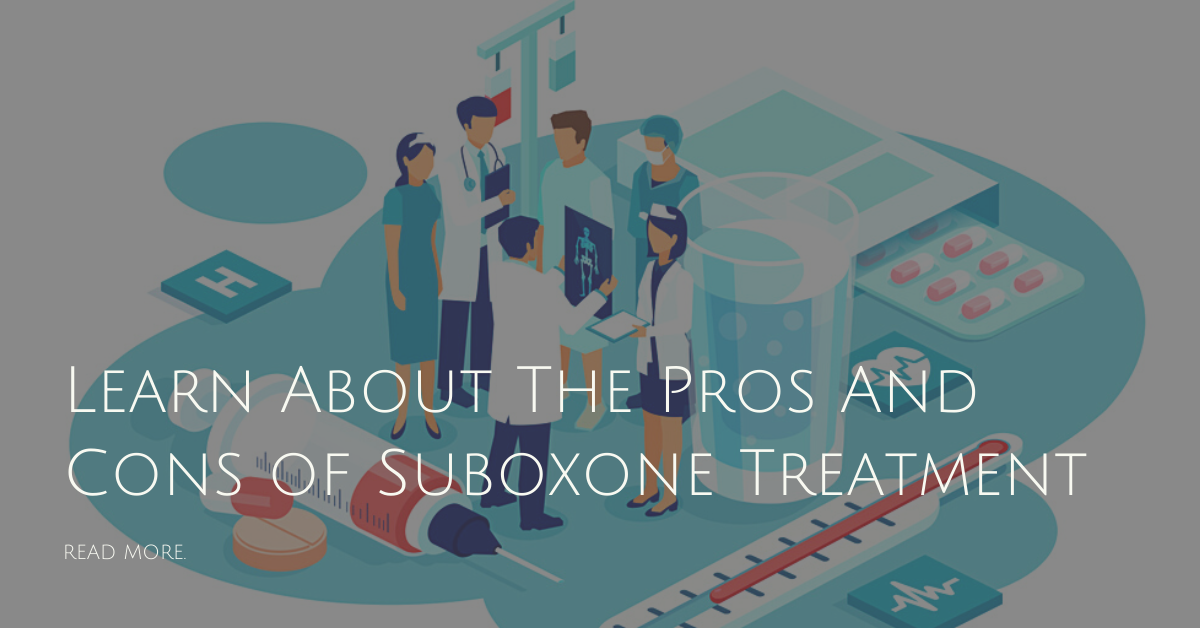
Learn about the Pros and Cons of Suboxone Treatment
Substance use disorder is a harsh reality all across the globe. Alcohol, tobacco, marijuana and other drugs are increasingly misused by people. The end of which is more than often not a favorable outcome. Among the millions that suffer from substance use disorder, a major fraction of the number, 3 million to be precise, suffer or have suffered from opioid use disorder in the US. The fatality rate of the same is discouraging as well. The numbers are high enough for the US Department of Health and Human Services to identify OUD as a national public health crisis.
Now that you have had a peek of the dark reality, let me introduce you to the silver lining. There is an easy and convenient way that can help all the people battling with opioid use disorder. It’s called suboxone treatment. It is just another medication that is used in medication-assisted therapy to help the patient return to sobriety. It is safe and very effective.
So if you are considering starting suboxone treatment or are on the edge of making a decision, let me help you out. Read along to find all the important details including the pros and cons of suboxone treatment.
Table of Contents
What is Suboxone?
Suboxone is a prescribed combination medication that consists of two main components- Buprenorphine and Naloxone. Suboxone works as a means of reducing opioid dependence in OUD patients. This medication is generally used in medication-assisted therapy and has shown very positive results since its use began.
The two components of Suboxone are the reason behind its effectiveness. Buprenorphine is a partial opioid agonist. In simple terms, it is like opioids but only partially. It binds with the different opioid receptors in the body and produces effects such as euphoria or high, respiratory depression etc. But unlike opioids, which are full opioid agonists, the effects of buprenorphine are very mild.
On the other hand, naloxone is essentially a pure opioid antagonist. This means that it prevents the absorption of opioids into the opioid receptors of your body. So, it helps avoid the intense effects and dependence on opioids. Also, it does not have any agonistic attributes which means that it doesn’t cause any effects similar to opioids.
Using suboxone isn’t easy but it is not rocket science either. It will take some time for your body to adjust to the medication. But with proper dosage from the doctor and determination, perseverance and discipline from your side will result in only positive results.
What is The Use of Suboxone?
Suboxone is one of the most preferred medications for substance use disorder, especially for people looking for opioid addiction recovery. As we’ve already discussed, suboxone is best used as a part of medication-assisted therapy. Because opioids or any other narcotic addiction not only negatively affects your physical health but totally disrupts the mental and emotional well being as well. For this reason, suboxone can do much better when combined with proper therapies from medical professionals.
Let’s understand some more about Suboxone. It is a maintenance medication which means that its administration helps relieve the unwanted symptoms of opioids. Opioids are known for causing intolerable side effects such as difficulty in breathing, increased sensitivity to pain and constipation. The level of severity of these symptoms may vary in different people but in the case of abuse, the withdrawal is usually severe. This is where suboxone helps. It acts like aid in detoxifying the body from an excess of addicting opioids. In addition to this, suboxone helps in making the acute withdrawal symptoms from opioids and cravings more bearable.
With continuous use under controlled circumstances, suboxone can help reduce the chances of an opioid overdose.
Pros of Suboxone Treatment

The effectiveness of suboxone treatment is the reason why it is the first medication that is approved by the Food and Drug Association to be prescribed for opioid addiction in physicians’ offices. Along with proving to be a helpful treatment against OUD, Suboxone treatment has the following benefits.
It is Discreet
One of the major concerns among people undergoing or considering starting opioid recovery programs is the questionable stares and judgment. The stigma exists in the society related to substance use disorder which makes it difficult for the patient to reach out for help. So, if you have the same concern, no need to worry. Suboxone treatments ensure that your privacy is maintained.
You can visit a nearby physician and ask them for a consultation. They will prescribe you the medication and you can get it filled from your local pharmacist. So you can continue your treatment at your home without being away from your friends and family. Also, the medications are usually in the form of small sublingual or buccal strips or films coated with suboxone. You place it under your tongue or between your gums and cheek and let it dissolve. It makes the intake process also discrete thus giving you your privacy.
Eliminates Psychological Cravings
Cravings are a very common aspect of recovery programs. But it is also very common for patients to relapse while undergoing recovery. To avoid relapses, the main obstacle is to overcome physical as well as psychological cravings. Suboxone has the ability to quell cravings or at least diminish them to a point where they are easily controllable.
Helps Focus on Recovery
In patients with OUD, the withdrawal symptoms are usually acute. Stomach cramps, diarrhea, anxiety, cravings and increased respiratory rate are some of the common symptoms. But, with suboxone treatment, these symptoms diminish significantly thus helping the patient to focus completely on recovery.
Cons of Suboxone Treatment
Though suboxone is an excellent way of treating opioid addiction, it also has some sons to its name just like every other medication. Let’s take a look at a few.
The Consumer May Experience Side Effects
Medicines are tricky and there is still a long way to go in understanding the effects of suboxone. This is why, while suboxone helps relieve opioid withdrawal symptoms, it does have its own side effects. Here are a few side effects of the medication:
- Headaches
- Disturbance in sleep
- Dizziness
- Nausea
- Diarrhea
- Lack of concentration
It Can be Abused
Suboxone treatment is meant to treat substance abuse disorders. However, it is also true that suboxone can lead to abuse. That’s because buprenorphine is partially antagonist which adds some probability for abuse. But again, since it does not bind with the opioid receptors completely, the effects are mild which makes the risk of abuse highly uncommon. So, if you are undergoing suboxone treatment or know of someone who is, make sure that you stick to the dose and duration. One dose of suboxone is enough for the day. Do not indulge more than what your doctor prescribes for your condition.
It Can Cause Withdrawals

With long term use without proper supervision, patients will develop some tolerance to the medication just like opioids. And if the treatment is discontinued abruptly, the patient may experience withdrawal symptoms. Nausea, fever, redness of skin, insomnia and headache are some of the most common withdrawal symptoms of suboxone. So while undergoing a recovery treatment using suboxone, it is very important that the consumer follows the instructions properly.
Who Can Prescribe Suboxone?
The best part about suboxone treatment is that it can only be prescribed by professionals who are adequately qualified. A medical professional must have gone through a training program about using suboxone for opioid addiction. After completing the program, the doctor must register or get a license from the Drug Enforcement Administration or DEA to register themselves for prescribing suboxone.
The medical professional also gets a unique identification number that is included in every suboxone prescription. So you can rest assured that you are laying your trust in the right place.
Conclusion
It may be difficult for people to understand the mindset of the person going through OUD. But it should never be an obstacle between your path to getting better. If you are suffering from OUD or any other substance use disorder, don’t hesitate to reach out for help. Connect with a doctor near you and get a consultation for your suboxone treatment. It can help you get back to sobriety and deal with the process in the best way possible.
Suboxone treatments are usually very discreet but even then, if you do not feel comfortable going outside, connect with a doctor from your home using telemedicine. It’s an easy, convenient, safe and totally discreet way of connecting with the professionals to get a suboxone treatment. All you have to do is register and fill in your details. One of the board-certified doctors will connect to you via video call for your consultation. And after assessing your present condition, history of medications and lifestyle, you will be given a suboxone prescription that must be followed as instructed.
So, get your prescription today to put an end to your suffering and to start a journey towards a sober and healthy life.
September 25, 2020

















